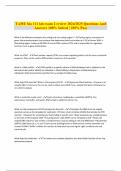Tamu bio 111 lab - Study guides, Class notes & Summaries
Looking for the best study guides, study notes and summaries about Tamu bio 111 lab? On this page you'll find 103 study documents about Tamu bio 111 lab.
Page 2 out of 103 results
Sort by
TAMU bio 111 lab exam 2 review 2024/2025 Questions And Answers 100% Solved | 100% Pass

-
TAMU bio 111 lab exam 2 review 2024 with 100% correct answers
- Exam (elaborations) • 8 pages • 2024
-
- $15.49
- + learn more
What is the difference between the coding and non-coding region? - correct answer Coding region: comprised of genes that encode proteins (instructions that determine traits) and makes up 1-2% of human DNA. • Noncoding region: makes up 98-99% of human DNA, contains STRs and is responsible for regulatory functions such as gene transcription. What are STRs? - correct answer Short-tandem repeats (STRs) are unique repeating patterns of the same nucleotide sequence. They can be used to differ...
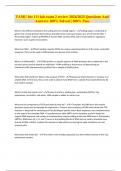
-
TAMU bio 111 lab exam 2 review 2024/2025 Questions And Answers 100% Solved | 100% Pass
- Exam (elaborations) • 8 pages • 2024
-
- $8.49
- + learn more
What is the difference between the coding and non-coding region? - Coding region: comprised of genes that encode proteins (instructions that determine traits) and makes up 1-2% of human DNA. • Noncoding region: makes up 98-99% of human DNA, contains STRs and is responsible for regulatory functions such as gene transcription. What are STRs? - Short-tandem repeats (STRs) are unique repeating patterns of the same nucleotide sequence. They can be used to differentiate one person from another....
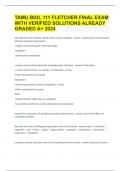
-
TAMU BIOL 111 FLETCHER FINAL EXAM WITH VERIFIED SOLUTIONS ALREADY GRADED A+
- Exam (elaborations) • 36 pages • 2023
- Available in package deal
-
- $14.99
- 1x sold
- + learn more
describe the basic functions all life forms must accomplish -response to environmental stimuli & maintain homeostasis -uptake and processing of nutrients/energy -regulation -growth and reproduction compare and contrast eukaryotic and prokaryotic cell types Prokaryotes: -circular chromosomes, no nucleus, no organelles, 3.5 bya -DNA concentrated in nucleoid Eukaryotes: -linear chromosomes, nucleus, organelles, 1.5 bya -DNA concentrated in nucleus Both: -cellular function takes p...
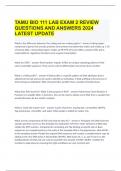
-
TAMU BIO 111 LAB EXAM 2 REVIEW QUESTIONS AND ANSWERS 2024 LATEST UPDATE.
- Exam (elaborations) • 9 pages • 2023
- Available in package deal
-
- $13.49
- + learn more
TAMU BIO 111 LAB EXAM 2 REVIEW QUESTIONS AND ANSWERS 2024 LATEST UPDATE.
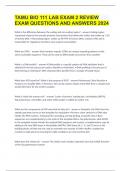
-
TAMU BIO 111 LAB EXAM 2 REVIEW EXAM QUESTIONS AND ANSWERS 2024
- Exam (elaborations) • 9 pages • 2023
- Available in package deal
-
- $14.49
- + learn more
What is the difference between the coding and non-coding region? Coding region: comprised of genes that encode proteins (instructions that determine traits) and makes up 1-2% of human DNA. • Noncoding region: makes up 98-99% of human DNA, contains STRs and is responsible for regulatory functions such as gene transcription. What are STRs? Short-tandem repeats (STRs) are unique repeating patterns of the same nucleotide sequence. They can be used to differentiate one person from another....

-
TAMU BIO 111 LAB EXAM 2 REVIEW QUESTIONS AND ANSWERS 2024 LATEST UPDATE.
- Exam (elaborations) • 9 pages • 2023
- Available in package deal
-
- $16.49
- + learn more
What is the difference between the coding and non-coding region? Coding region: comprised of genes that encode proteins (instructions that determine traits) and makes up 1-2% of human DNA. • Noncoding region: makes up 98-99% of human DNA, contains STRs and is responsible for regulatory functions such as gene transcription. What are STRs? Short-tandem repeats (STRs) are unique repeating patterns of the same nucleotide sequence. They can be used to differentiate one person from another....
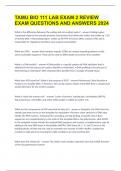
-
TAMU BIO 111 LAB EXAM 2 REVIEW EXAM QUESTIONS AND ANSWERS 2024
- Exam (elaborations) • 9 pages • 2023
- Available in package deal
-
- $15.49
- + learn more
TAMU BIO 111 LAB EXAM 2 REVIEW EXAM QUESTIONS AND ANSWERS 2024
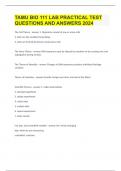
-
TAMU BIO 111 LAB PRACTICAL TEST QUESTIONS AND ANSWERS 2024
- Exam (elaborations) • 8 pages • 2023
- Available in package deal
-
- $15.49
- + learn more
The Cell Theory 1. Organisms consist of one or more cells 2. Cells are the smallest living things 3. Cells are formed by division of previous cells The Gene Theory DNA sequences may be altered by mutation or by crossing over and segregation during meiosis Brainpower Read More The Theory of Heredity Changes in DNA sequences produce individual heritage variation. Theory of Evolution Genetic change over time; Survival of the fittest Scientific Process 1. make ...

-
TAMU BIO 111 LAB PRACTICAL TEST QUESTIONS AND ANSWERS 2024
- Exam (elaborations) • 8 pages • 2023
- Available in package deal
-
- $15.49
- + learn more
The Cell Theory 1. Organisms consist of one or more cells 2. Cells are the smallest living things 3. Cells are formed by division of previous cells The Gene Theory DNA sequences may be altered by mutation or by crossing over and segregation during meiosis Brainpower Read More The Theory of Heredity Changes in DNA sequences produce individual heritage variation. Theory of Evolution Genetic change over time; Survival of the fittest Scientific Process 1. make ...

$6.50 for your textbook summary multiplied by 100 fellow students... Do the math: that's a lot of money! Don't be a thief of your own wallet and start uploading yours now. Discover all about earning on Stuvia

